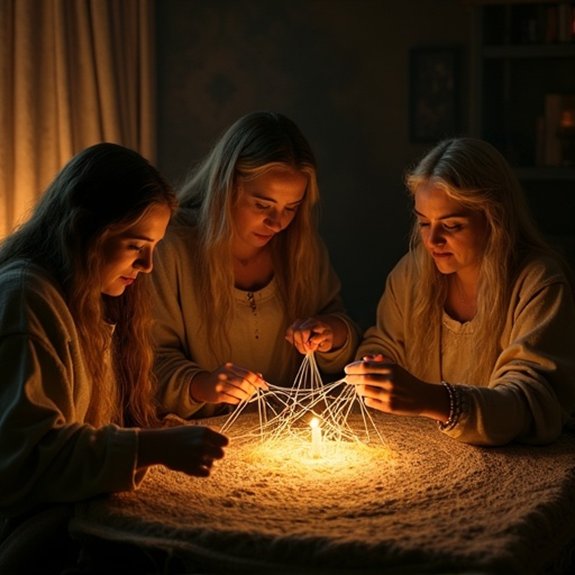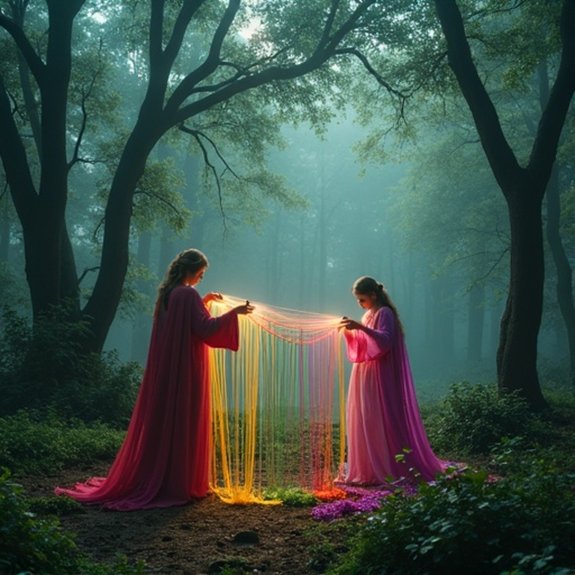The Moirai / Norns: Fate Weavers
The Moirai and Norns haven’t just shaped mythology—they’ve influenced how civilizations understand destiny itself. These fate weavers appear across centuries of art, literature, and folklore, their threads connecting ancient beliefs to modern philosophy. From Greek tragedies to Norse sagas, their presence raises an unsettling question: if even gods can’t escape predetermined fate, what chance do mortals have? The answer lies buried in thousands of years of human storytelling.
Introduction

When ancient civilizations first gazed at the stars and wondered about their destinies, they couldn’t have imagined that the concept of fate would evolve into one of humanity’s most enduring philosophical debates. The Greeks personified this force through the Moirai—three sisters who spun, measured, and cut life’s thread. Similarly, Norse mythology presented the Norns, powerful beings who carved destinies into Yggdrasil’s bark. These fate weavers didn’t merely predict futures; they actively shaped them. Their influence permeated every aspect of mortal and divine existence. Gods feared them, heroes challenged them, and common people prayed to them. Today’s scholars still examine how these mythological figures reflected ancient societies’ attempts to understand free will, predetermination, and life’s seemingly random events that shape human experience.
Ancient Greek Mythological Roots
The Moirai—Clotho, Lachesis, and Atropos—emerged from Greek cosmogony as daughters of Night (Nyx) or, in later traditions, Zeus and Themis. These three sisters controlled every mortal’s destiny from birth to death. Clotho spun the thread of life, determining when someone would be born. Lachesis measured the thread’s length, allotting each person’s lifespan and experiences. Atropos cut the thread with her shears, bringing inevitable death.
Even the Olympian gods couldn’t escape their decrees. The Moirai appeared at critical moments—births, marriages, and battles—to guarantee fate’s fulfillment. They’re often depicted as old women dressed in white robes, working at their eternal task. Their dwelling place varied in myths, sometimes placed in Olympus, other times in the underworld near Hades’ domain.
Notable Cases or Sightings

Throughout history, witnesses have claimed encounters with mysterious women who appeared at pivotal moments to foretell death or disaster. Medieval chronicles describe three cloaked figures visiting royal deathbeds across Europe. In 1692, Salem trial records mention “three sisters” who’d allegedly cursed villagers’ fates before the witch hysteria began.
Norse sagas contain numerous accounts of the Norns appearing to warriors before battle. The Völuspá describes them sitting beneath Yggdrasil, carving runes that sealed men’s destinies. Scottish folklore tells of washerwomen at fords who’d predict soldiers’ deaths by displaying their bloodied clothes.
Modern sightings remain rare but persistent. In 1917, three Portuguese children reported visions of a luminous woman who revealed future calamities. Similar accounts emerged from World War II’s battlefields, where soldiers described elderly women warning of ambushes.
Common Theories or Explanations
While skeptics dismiss fate weavers as mere folklore, several theories attempt to explain these persistent accounts across cultures. Jungian psychologists propose they’re archetypal manifestations of humanity’s collective unconscious—symbols representing our need to find meaning in random events. They argue that ancient peoples created these entities to cope with life’s unpredictability.
Anthropologists suggest fate weavers emerged from early textile societies where weaving held sacred significance. The act of creating fabric paralleled life’s interconnected nature, making weavers natural metaphors for destiny’s architects.
Some quantum physicists theorize these beings might represent intuitive understanding of probability waves and parallel universes. They’ve noted similarities between fate weaver descriptions and modern concepts of quantum entanglement, where observation affects outcomes—though mainstream science doesn’t support supernatural interpretations.
Frequently Asked Questions
Can Mortals Change Their Fate Once the Moirai Have Woven It?
No, mortals can’t change their fate once the Moirai have woven it. They’ve predetermined every person’s destiny at birth, and even the gods can’t alter these threads. Fate remains immutable and absolute.
What Tools or Objects Do the Fates Use Besides Thread and Scissors?
The Fates use spindles to spin life’s thread, measuring rods to determine each mortal’s allotted time, tablets to record destinies, and looms to weave fate’s tapestry. They’ve also wielded shears, distaffs, and scrolls throughout mythology.
Are There Specific Rituals to Appease or Honor the Moirai?
Ancient Greeks honored the Moirai through offerings of honey, flowers, and wool at their shrines. They’d invoke them during births, marriages, and deaths. Romans called them Parcae and performed similar rituals at crossroads.
Do the Norns and Moirai Represent the Same Concept Across Cultures?
They represent similar but distinct concepts. Both weave fate, but Norns emphasize cosmic order and cyclical time while Moirai focus on individual destiny’s thread. Norse fate’s more negotiable; Greek fate’s typically absolute and unchangeable.
What Happens to a Person’s Thread After They Die?
The thread’s cut by Atropos signifies death’s finality in Greek mythology. Some traditions suggest it’s woven into the cosmic tapestry, while others believe it returns to the universal fabric from which all fates originate.


